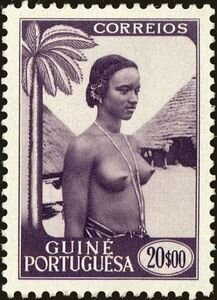Stamp: Aborigine-girl (Portuguese Guinea 1948)
Aborigine-girl (Portuguese Guinea 1948)
01 April (Portuguese Guinea ) within release Guinea local images goes into circulation Stamp Aborigine-girl face value 20 Portuguese Guinean escudo
| Stamp Aborigine-girl in catalogues | |
|---|---|
| Michel: | Mi: PT-GN 270II |
Stamp is square format.
stamp from souvenir sheet - without imprint Footnoted but not listed separately by Sn, Yt or MundifilAlso in the issue Guinea local images:
- Stamp - Aborigine face value 20;
- Stamp - Aborigine into Country-dress face value 35;
- Stamp - Aborigine-girl face value 20;
- Stamp - Aborigine-House face value 5;
- Stamp - Aborigine-man face value 70;
- Stamp - Aborigine-man face value 3.50;
- Stamp - Aborigine-woman face value 80;
- Stamp - Aborigine-woman face value 5;
- Stamp - Black Crowned Crane (Balearica pavonina) face value 10;
- Stamp - Bushbuck (Tragelaphus scriptus) face value 1.75;
- Stamp - Drummer face value 1;
- Stamp - Drummer face value 2;
- Stamp - Musician face value 50;
Stamp Aborigine-girl it reflects the thematic directions:
The nude, as a form of visual art that focuses on the unclothed human figure, is an enduring tradition in Western art. It was a preoccupation of Ancient Greek art, and after a semi-dormant period in the Middle Ages returned to a central position with the Renaissance. Unclothed figures often also play a part in other types of art, such as history painting, including allegorical and religious art, portraiture, or the decorative arts. From prehistory to the earliest civilizations, nude female figures were generally understood to be symbols of fertility or well-being.
The Arecaceae is a family of perennial, flowering plants in the monocot order Arecales. Their growth form can be climbers, shrubs, tree-like and stemless plants, all commonly known as palms. Those having a tree-like form are called palm trees. Currently, 181 genera with around 2,600 species are known,
most of which are restricted to tropical and subtropical climates. Most palms are distinguished by their large, compound, evergreen leaves, known as fronds, arranged at the top of an unbranched stem, except for the Hyphaene genus, who has branched palms. However, palms exhibit an enormous diversity in physical characteristics and inhabit nearly every type of habitat within their range, from rainforests to deserts.


